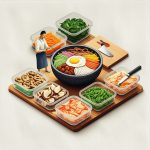Love egg rolls but worried about their nutritional impact? You’re not alone! This comprehensive guide breaks down everything you need to know about the calories, fats, and other nutrients in egg rolls. We’ll explore different kinds—fried, baked, veggie, meat—and clear up the confusion surrounding their nutritional content. You’ll also discover how to make healthier versions at home and find tips for making smart choices when eating out. A registered dietitian offers helpful advice on portion sizes and how to fit egg rolls into a balanced diet. For similar appetizer insights, check out this crab rangoon nutrition guide. Let’s dive into egg roll nutrition!
Egg Roll Nutrition Facts: A Detailed Overview
Let’s talk egg rolls. They’re undeniably delicious, but have you ever truly considered their nutritional content? The nutritional information for egg rolls can be quite variable, influenced by factors such as ingredients, size, and cooking method. For instance, a deep-fried egg roll differs significantly from a baked one.
Decoding the Numbers: Understanding What’s in Your Egg Roll
Determining the exact nutritional content of an egg roll can be challenging. Online sources often provide conflicting information, with calorie counts ranging from 100 to 250 per roll and fat content varying from 7 to 15 grams. Protein content can also fluctuate between 6 and 10 grams per roll. This inconsistency highlights the need for greater transparency from food companies.
Here’s a general overview, keeping in mind that these are averages and can vary:
| Nutrient | Typical Range per Egg Roll |
|---|---|
| Calories | 150-250 |
| Total Fat (grams) | 7-15 |
| Saturated Fat (grams) | 2-5 |
| Cholesterol (milligrams) | 10-40 |
| Sodium (milligrams) | 300-500 |
| Total Carbohydrates (g) | 20-30 |
| Dietary Fiber (grams) | 2-3 |
| Sugars (grams) | 2-6 |
| Protein (grams) | 6-10 |
Cooking Methods: The Impact of Frying vs. Baking
The cooking method employed significantly influences an egg roll’s nutritional profile. Deep-frying introduces excess oil and calories, while baking or air-frying results in a healthier option with fewer calories and less fat.
Making Smart Choices: Tips for Healthier Egg Roll Consumption
Here’s how to navigate the egg roll nutritional landscape and make informed decisions:
- Read Nutrition Labels: Carefully examine ingredient lists and nutrition facts before purchasing. Look for options with lower calorie and sodium counts.
- Opt for Baking or Air Frying: Choose baked or air-fried egg rolls whenever possible. They represent a healthier alternative to deep-fried varieties.
- Practice Portion Control: Egg rolls are calorie-dense, so moderation is crucial.
- Be Aware of Allergens: Egg rolls often contain common allergens like eggs, wheat, and soy. Scrutinize ingredient lists if you have allergies.
- Consider Homemade Options: Making your own egg rolls allows for complete control over ingredients, enabling you to tailor them to your dietary needs and preferences.
Addressing Inconsistent Information: The Need for Standardized Reporting
Inconsistent nutritional information is a significant issue. Discrepancies between sources are likely due to variations in ingredients, sizes, and cooking methods. Clearer labeling and standardized reporting by food producers are essential for consumer confidence.
The Bottom Line: Moderation is Key
Egg rolls can be part of a balanced diet. Understanding their nutritional information empowers you to make healthier choices. By carefully considering cooking methods, portion sizes, and accompanying foods, you can enjoy this treat responsibly.
Reducing Sodium in Homemade Egg Rolls
Key Takeaways:
- Homemade egg rolls offer greater control over sodium levels than restaurant versions.
- Strategic ingredient swaps are essential for sodium reduction.
- The “egg roll in a bowl” concept provides a simplified, lower-fat alternative.
- Nutritional information varies; always check labels and adjust recipes.
Understanding the Sodium Challenge
Restaurant egg rolls frequently contain high sodium levels. Making them at home allows you to significantly reduce the salt content through informed ingredient and cooking method choices.
Ingredient Swaps: A Sodium-Reduction Strategy
Traditional egg roll recipes rely heavily on soy sauce. Consider these sodium-conscious alternatives:
- Low-Sodium Soy Sauce: A common choice but may still contain significant sodium compared to other options.
- Reduced-Sodium Worcestershire Sauce: Offers umami depth with less salt.
- Balsamic Vinegar Reduction: Provides a tangy-sweet flavor, reducing the need for added salt.
- Homemade Soy Sauce Alternative: Experiment with rice vinegar, molasses, and low-sodium bouillon for an authentic taste.
Cooking Methods: Beyond Deep Frying
Deep-frying significantly increases fat content. Opt for these healthier alternatives:
- Baking: Produces crispy egg rolls with less oil.
- Air Frying: Minimizes fat and offers faster cooking.
- Pan-Frying: Employs minimal oil in a non-stick pan.
- Egg Rolls in a Bowl: Skip the wrappers altogether; sauté your filling and serve it over rice or noodles.
Recipe Variations: Customizing to Your Tastes
Homemade egg rolls are customizable. Modify fillings to control sodium levels:
- Leaner Proteins: Choose chicken breast, turkey, or tofu over fatty pork.
- Abundant Vegetables: Cabbage, carrots, and mushrooms naturally lower sodium.
- Fresh Herbs and Spices: Garlic, ginger, and other herbs enhance flavor, reducing the need for salt.
Nutritional Considerations: A Holistic Approach
While sodium reduction is important, consider the overall nutritional value. Aim for a balance of protein, carbohydrates, and vegetables. Always verify the sodium content.
The Bottom Line: A Healthier Indulgence
Mastering how to reduce sodium in homemade egg rolls allows you to enjoy this classic dish without compromising your health. Experiment with the strategies above to discover your preferred balance of flavor and nutrition.
Choosing Healthier Egg Roll Options: Cooking Methods and Ingredients
Key Takeaways:
- Spring rolls generally offer a healthier nutritional profile than egg rolls.
- Healthier egg roll choices depend on cooking method and ingredients.
- Deep-frying increases fat and calorie content.
- Baking or air-frying are healthier alternatives.
- Pay attention to serving sizes and sauces.
- Opt for whole-wheat wrappers.
Understanding the Nutritional Landscape
Craving egg rolls? Let’s examine how to make informed choices. Remember, spring rolls are often lighter due to thinner wrappers and less frying.
Cooking Techniques: The Decisive Factor
The primary determinant of an egg roll’s healthfulness is its cooking method. Deep-fried options are significantly higher in fat and calories compared to baked or air-fried versions.
Ingredient Selection: A Key to Nutritional Value
The type of ingredients used in the filling also plays a crucial role. Opt for lean proteins, such as chicken or tofu, and load up on vegetables like cabbage, carrots, and bean sprouts. Minimize the use of high-sodium ingredients such as soy sauce; reduced-sodium alternatives or fresh herbs and spices are preferable.
Portion Control and Sauce Selection
Serving size matters. Stick to one or two egg rolls as an appetizer rather than making them the main course. Be mindful of the dipping sauce; many are high in sugar and sodium. Instead, consider a light vinaigrette or a small amount of low-sodium soy sauce.
Exploring Healthier Alternatives
Consider these strategies for healthier egg roll consumption:
- Order Spring Rolls: Spring rolls are frequently a lighter alternative because they are prepared with a thinner wrapper and are often not fried.
- Request Baking or Air-Frying: If accessible, ask for baked or air-fried egg rolls when ordering at a restaurant.
- Choose Whole-Wheat Wrappers: Opt for egg rolls made with whole-wheat wrappers to boost fiber intake.
- Make Your Own: Homemade egg rolls enable you to regulate the ingredients and cooking method, empowering you to develop a healthier variation.
The Bottom Line: Make Informed Choices
Egg rolls can be an element of an occasional treat, but being mindful of cooking methods, ingredients, and portion sizes is essential. By deciding on leaner ingredients, baking or air-frying, and savoring them in moderation with a light dipping sauce, you can enjoy this tasty dish with a more nutritious approach.
- Your Perfect Bento Box Bag For Fresh And Tidy Meals - December 2, 2025
- Korean Meal Prep Made Easy For Delicious Weekday Meals - December 1, 2025
- Korean Food Meal Prep Makes Flavorful Weekday Meals Simple - November 30, 2025










